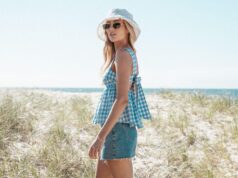A Rue de l’Université hôtel particulier was lit up like a James Turrell installation, and in an upstairs room Zegna’s Alessandro Sartori and The Elder Stateman’s Greg Chait were taking meetings. The Paris launch of their collaboration, two-and-a-half years in the making, was scheduled to get underway in a couple of hours.
The century-old Italian maker of fine suits and the Southern Californian upstart purveyor of tie-dyed cashmere sweaters may look like an odd couple, but isn’t that how best collaborations are made? Though they come from different places, both labels put material at the center of their practice, and both men are really, truly crazy about yarn.
“We started with meaning—not a marketing reason,” Sartori said. We can do many collabs, they can do as many or more collabs; we are full of brands asking, but we do fairly few projects. We started by saying, if we do it, what can we do to be happy in the journey?” The answer was cashmere yarn.
“Being able to build yarns for this collection, that’s so exciting to me,” Chait said. “We’re a vertical business ourselves; we do hand dyeing and hand looming and hand weaving, but the yarn has always been what has been so fascinating to me and that’s how I started, randomly learning how to hand spin yarn. The yarn is the unsung hero of actually everything.”
“It’s the food of fashion,” Sartori interjected.
At Zegna, Sartori has developed a strong belief that knit is the “media of the future”—not just for sweaters, but for items that are typically made using wovens, like jackets and suiting. In fact, under his guidance, Zegna’s runway shows have moved away from the traditional tailoring that the brand was founded on. This collaboration features many such knit pieces, including button-downs made from cashmere brushed on the front side to a downy shag, but smooth on the inside against the skin. The technique is not only aesthetically pleasing, but Sartori suggests that it protects the material. Eventually, it can be handed down or recycled because there’s no construction. To extend the food metaphor, there’s no bad-for-you additives, just natural fibers made in a traceable way.
The shirts and pants in that shaggy cashmere are tempting, not least of all because of The Elder Statesman’s sensational colors, which are rooted in its Venice Beach origins. Among the other temptations: a long puffer in knitted cashmere stripes on the outside, a cashmere “flannel” in sun-faded colors, and slouchy corduroy suits made with a 90/10 cashmere and cotton blend, for durability, in shades of lilac, yellow, and berry pink. Delicious.









